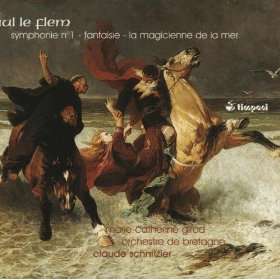|
Back
08/08/2012
Paul Le Flem: La Magicienne de la Mer: Two Interludes – Fantaisie for piano and orchestra – Symphony nº 1 in A major
Marie-Catherine Girod (Piano), Orchestre de Bretagne, Claude Schnitzler (Conductor)
Recording: Rennes, France (October 22-25, 1993) – 68’08
Timpani #1C1123 – Booklet in French and English

   
Today, little is mentioned of Paul Le Flem, a man who followed in the shadows of Claude Debussy and Maurice Ravel. Native to Brittany, Le Flem studied under Albert Roussel and Vincent d’Indy. All the aforementioned were influential, yet Le Flem created a vibrant style unlike any other. Timpani collects a nice sampling of his music on this CD.
Le Flem wrote several short operas, including La Magicienne de la Mer which opens the CD with two excerpted interludes from the work. The first piece, “Dahut’s Call” (“L’Appel de Dahut”), wallows in broodiness and entrees with a distinctly gradient crescendo. Le Flem concocted his own version of the story surrounding the legendary town of Ys that pulsates in tension and broadens the limits of expected Impressionism, yielding a seemingly Cinemascope magic. The use of atonality, polytonality and pronounced phrasing along with an enlarged orchestra makes this a very dramatic score.
Fantaisie for piano and orchestra evokes a seascape within easy reach of St. Malo featuring undulating and bounteous sweeps that lead into Marie-Catherine Girod’s marvelous dexterity on piano hinting at points of Gershwin, Korngold and some degreed Rachmaninoff. Measure for measure, this Fantaisie packs powerful lyricism of maritime might and is worth exploring again and again.
In the Symphony nº 1 in A major we discover a vivid symphonic poem constructed in four movements. Le Flem’s connective mix of native Lezardriex and open waters is strongly exemplified in the opening “Lent; animé.” There is such a richness about this music, a display of Breton folk coloring, yet a bit of tender sadness. But the emotional tones are forever flittering so one never becomes complacent.
Subsequently, “Lent” begins and ends with plaintive calls from the oboe soon accompanied by background harp. The section is more melancholic and somber with bolts of sudden forte which last for only a few brief seconds.
A repetitive six-note phrase anchors the “Scherzo; assez animé”, and it is here where we find glances of Debussy’s “Fêtes” from Nocturnes. A galloping 6/8 rhythm anchors the remaining track, “Finale; assez animé.” There is a sharp, effervescent and wild happiness to the music, allowing several different instruments to grab hold of the familiar melody in a “variation” format. The final measures sign off with joyful punch, a fitting tribute to Le Flem.
E.V. Luminais’ painting, The Flight of King Gradlon, was favorably received in the Salon de Paris back in 1884. This beautifully romantic painting (depicting the final tragic moments surrounding Ys) is featured on the front cover. This provides a fitting, and striking presentation of what one will find inside. There is novel enchantment within the musical pages of Paul Le Flem.
Christie Grimstad
|